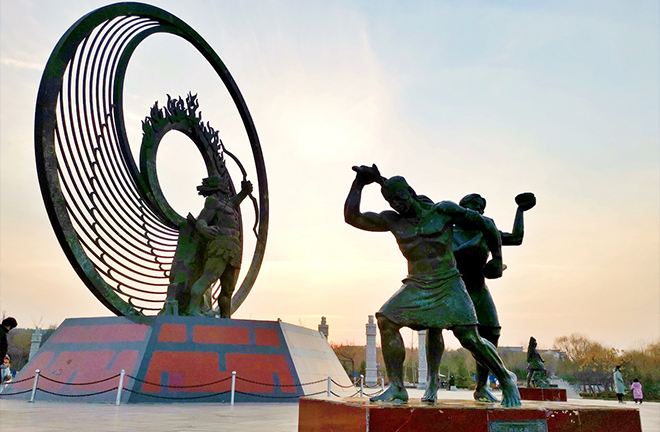Dongyi culture played key role in early Chinese civilization

Statues at the Dongyi culture plaza in Qingzhou, Weifang, Shandong Province Photo: TUCHONG
From July 21 to 22, scholars gathered in Ji’nan, capital of east China’s Shandong Province, to attend a symposium on Dongyi culture and the formation of the “unity in diversity” ethos of Chinese civilization.
The term “Dongyi,” meaning “eastern barbarian tribes” in ancient Chinese history, refers to people living east of the Central Plains, where inhabitants considered themselves civilized. The Dongyi people primarily inhabited a vast region stretching from eastern Henan Province to the coastal areas and islands of the Bohai and Huanghai seas. They developed an independent, distinct, and far-reaching Dongyi culture, which played a significant role in the early stage of Chinese civilization and the formation of its “unity in diversity” cultural characteristic.
Zhang Fenglian, vice president of the Shandong Academy of Social Sciences (SASS), pointed out that the formation, development, and evolution of Dongyi culture, a significant cultural component of ancient Chinese civilization, were integral to the progression of Chinese civilization from diversity to unity in history.
The formation of Dongyi culture and its relationship with the Xia (c. 21st century–16th century BCE), Shang (c. 16th century–11th century BCE), and Zhou (c. 11th century–256 BCE) dynasties in the Central Plains in the early development of Chinese civilization has long been a focus of research. Fang Hui, director of the Institute of Cultural Heritage at Shandong University, emphasized the important role of ritual practices in shaping culture.
After examining human bone samples unearthed from various archaeological sites in the Central Plains and the Haidai area—which includes Shandong and its neighboring regions centered around Mount Tai, Fang identified a major difference in the ritual behaviors of the Xia and Dongyi peoples: kneeling was a common ritual act in the Xia Dynasty, while Dongyi ethnic groups were more accustomed to squatting. As the Shang regime conquered other parts of ancient China, kneeling became part of the ritual system in neighboring regions, reaching the Haidai area by the mid-Shang Dynasty at the latest.
The ritual system is a defining feature of ancient Chinese civilization. Multiple coffins discovered from the Jiaojia site in the Haidai area, alongside the institutionalization of burial jade, stone, and pottery ritual vessels, have provided early systematic evidence for the origins of the Chinese ritual system.
In the view of Yang Wensheng, vice president of the Henan Provincial Institute of Cultural Heritage and Archaeology, the migration of the Xia people from the east to the Central Plains marked the first wave of ethnic integration. The congeniality and continuity of ritual customs of the Xia, Shang, and Zhou embodied the diversity and unity of Chinese culture, a proposition supported by archaeological findings.
Academia was long subject to the influence of renowned Chinese historian Fu Sinian’s “Eastern Yi and Western Xia hypothesis” (Yixia dongxi shuo), which posited that Chinese culture emerged from an east-west convergence between the Dongyi and Huaxia, predominantly Han, ethnic groups in the Central Plains. However, Du Yong, a professor of history at Shandong University, contended that the relationship between Dongyi and Huaxia cannot be fully encapsulated by this east-west dichotomy. He argued that the Xia Dynasty’s rule over areas inhabited by the Dongyi people should be understood within the context of the dynasty’s structure of unity in diversity.
In terms of research methodology, Liu Yuan, a research fellow from the Institute of Ancient History at the Chinese Academy of Social Sciences, suggested that scholars specializing in ancient civilization should learn from prestigious historian and archaeologist Li Xueqin’s studies of bronze inscriptions, which included consulting ancient documents and cross-referencing scripts on oracle bones unearthed from the Yinxu Site in Anyang, Henan, to bronze inscriptions dating to the Western Zhou Dynasty (c. 11th century–771 BCE). Liu called for more attention to historical studies to scrutinize related figures, events, and institutions.
The symposium was hosted by the Institute of History at SASS.
Edited by CHEN MIRONG
